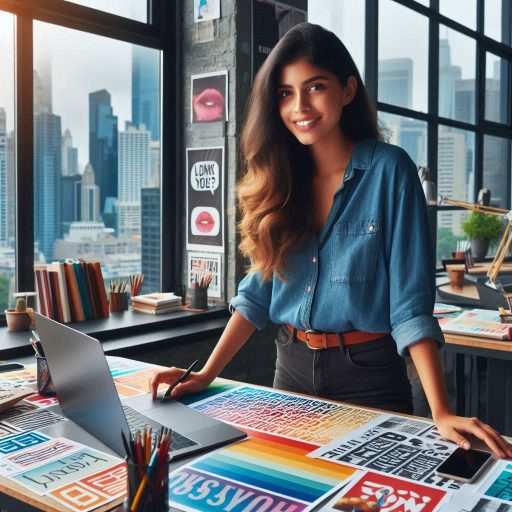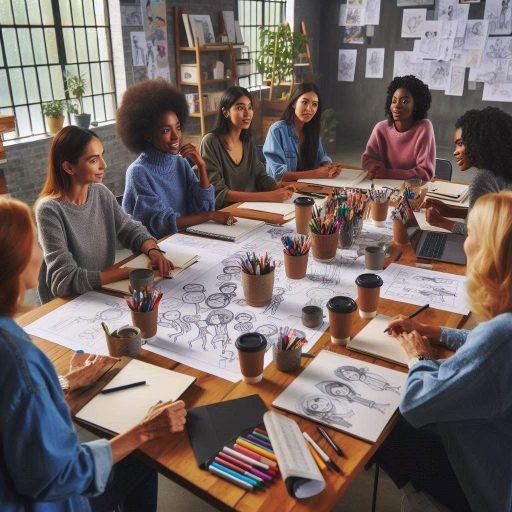Introduction
Balancing creativity and functionality in design is crucial for achieving effective outcomes.
Creativity fuels innovation, allowing designers to explore new ideas and push boundaries.
Creative concepts breathe life into projects, making them visually appealing and engaging.
However, functionality ensures that designs serve their intended purpose and meet user needs.
A successful design harmonizes both aspects, creating an enjoyable and effective experience for users.
Designers must navigate this delicate balance to avoid overly artistic concepts that compromise usability.
When creativity overshadows functionality, designs can become impractical and frustrating for users.
Striking the right balance enhances user experience and increases satisfaction.
Effective design not only captivates the audience but also provides seamless interactions and clear communication.
This balance is vital across various design disciplines, including graphic design, product design, and web design.
Users appreciate designs that look good and work seamlessly.
Therefore, designers must prioritize understanding user needs while exploring innovative solutions.
Designers should embrace experimentation while remaining grounded in usability principles.
In this blog, we will explore various strategies for achieving this balance.
We will highlight how creativity and functionality can coexist to produce exceptional design outcomes.
By prioritizing both elements, designers can create memorable experiences that resonate with users and drive engagement.
Understanding the role of creativity in design
When it comes to design, creativity plays a crucial role in shaping the entire process.
Creativity is what sets a design apart from the rest and allows it to stand out in a crowded marketplace.
Creative thinking is essential for pushing boundaries, exploring new ideas, and ultimately creating something innovative and unique.
How creativity drives the innovation and uniqueness of a design
- Creativity is the driving force behind innovation in design.
- By thinking outside the box, designers can come up with fresh and original ideas.
- These ideas often lead to groundbreaking solutions that revolutionize the industry.
- Through creative thinking, designers can push the boundaries of what is possible and create designs that are truly unique.
Examples of creative design solutions that have successfully balanced functionality
- One example of a creative design solution that successfully balances functionality is the Dyson Airblade hand dryer.
- Designed by Sir James Dyson, the Airblade uses innovative technology to dry hands in a matter of seconds, all while being energy-efficient and hygienic.
- Another example is the Nest Thermostat, which combines sleek design with smart technology to create a highly functional yet aesthetically pleasing product.
- The Tesla Model S is yet another example of a design that seamlessly blends creativity and functionality, offering a luxurious, high-performance electric vehicle.
In review, balancing creativity and functionality in design is essential for creating innovative and successful products.
By understanding the role of creativity, discussing how it drives innovation, and providing examples of creative design solutions, we can see how creativity plays a crucial role in shaping the world of design.
Understanding the role of functionality in design
Functionality plays a crucial role in design as it determines how practical and user-friendly a product or space is.
It involves the way the design fulfills its intended purpose efficiently and effectively.
When designers prioritize functionality, they ensure that the design serves its intended purpose without compromising on usability or convenience.
This approach helps create designs that are not only aesthetically pleasing but also highly functional.
The importance of functionality in ensuring that a design is practical and user-friendly
Functionality is essential in ensuring that a design is practical and user-friendly because it directly impacts the usability and effectiveness of the design.
A design that lacks functionality may look great but fail to serve its purpose effectively.
By prioritizing functionality, designers can create products or spaces that are easy to use, intuitive, and efficient.
This, in turn, enhances the overall user experience and ensures that the design meets the needs and expectations of its users.
Without functionality, a design may be visually appealing, but it may not be practical or user-friendly.
This can lead to frustration, inefficiency, and ultimately, a design that fails to fulfill its intended purpose.
Examples of designs that prioritize functionality over creativity
- The classic Swiss Army Knife: This versatile tool is a perfect example of a design that prioritizes functionality over creativity.
While its design may not be groundbreaking, its practicality and usefulness are unmatched. - The IKEA Billy Bookcase: Known for its simple and functional design, the Billy bookcase is a staple in many homes.
Its straightforward construction and easy assembly make it a practical choice for storage solutions. - The Apple iPhone: Apple’s iconic smartphone is another example of a design that focuses on functionality.
Its user-friendly interface, intuitive features, and seamless integration make it a preferred choice for millions of users worldwide. - The Herman Miller Aeron Chair: A popular choice for office seating, the Aeron chair is designed for comfort, ergonomics, and support.
While its design may not be flashy, its focus on functionality has made it a top choice for professionals. - The Google Search Engine: Google’s search engine is a prime example of a design that prioritizes functionality above all else.
Its simple interface, accurate results, and fast response time make it the go-to choice for internet searches.
These examples demonstrate how prioritizing functionality in design can lead to products and spaces that are highly practical, user-friendly, and effective.
While creativity is essential in design, it should always be balanced with functionality to ensure that the end result meets the needs and expectations of users.
Read: Essential Skills for Aspiring Costume Designers
Finding the balance between creativity and functionality
Strategies for Incorporating Creativity and Functionality in Design
Start with User Needs
Begin by identifying the user‘s needs.
Functionality should always prioritize the user experience.
However, creativity can enhance usability.
For example, using innovative layouts or interactive elements can engage users while keeping the design practical.
Focus on Simple, Clean Designs
Minimalism helps blend creativity and functionality seamlessly.
Simple designs are often the most effective.
Clean layouts, clear typography, and intuitive navigation make the design easy to use without sacrificing visual appeal.
Avoid clutter to maintain functionality while showcasing creative elements.
Use Consistent Visual Hierarchy
A well-planned visual hierarchy ensures the design communicates its message effectively.
This strategy helps balance creative and functional aspects.
Creativity can shine through fonts, colors, and graphics while the hierarchy guides users to the most important information.
Test and Iterate Frequently
Regular testing ensures that the design functions as intended.
User testing reveals potential issues with functionality and helps refine creative choices.
By iterating based on feedback, designers can strike the right balance between aesthetics and usability.
Read: Networking Events for Costume Designers
Challenges of Balancing Creativity and Functionality
Overcomplicating the Design
Sometimes creativity can lead to overly complex designs that confuse users.
Balancing artistic expression with simplicity is crucial.
To overcome this, always keep the user’s journey in mind.
Ensure every design choice serves a functional purpose.
Meeting Client Expectations
Clients may have different views on the balance between creativity and functionality.
While some clients focus on aesthetics, others emphasize practicality.
Communicating the value of both aspects is essential.
Present design concepts that blend the two and explain how creative elements can enhance user experience.
Designing for Multiple Platforms
Designing for various devices, such as smartphones and desktops, poses unique challenges.
A highly creative design may work well on one platform but fail on another.
Use responsive design principles to ensure your design functions across all devices without losing its creative edge.
Tips for Overcoming Challenges
Prioritize Purpose Over Aesthetics
Always ensure the design serves its intended purpose.
Creative elements should support, not overshadow, functionality.
Keep user goals and brand messaging at the forefront of every design decision.
Collaborate with Other Stakeholders
Collaboration helps balance creativity and functionality.
Work closely with developers, clients, and users to refine the design.
This ensures all aspects of the project align with the design‘s goals.
Transform Your Career Today
Unlock a personalized career strategy that drives real results. Get tailored advice and a roadmap designed just for you.
Start NowIn review, balancing creativity and functionality in design requires clear strategies and thoughtful decision-making.
Designers can overcome challenges by testing frequently, focusing on user needs, and collaborating with stakeholders.
Read: Building a Portfolio for Costume Design
Case Studies of Successful Designs That Balance Creativity and Functionality
In the world of design, finding the perfect balance between creativity and functionality is essential.
Let’s take a look at some successful designs that have achieved this delicate equilibrium
The iPhone
Apple’s iPhone is a prime example of a design that seamlessly blends creativity and functionality.
The sleek and stylish aesthetic appeal of the device is matched by its intuitive user interface and powerful features.
The minimalist design elements not only look visually appealing but also serve a practical purpose by allowing for a user-friendly experience.
The attention to detail in both form and function has made the iPhone a standout success in the market.
The Eames Lounge Chair
Designed by Charles and Ray Eames in the 1950s, the Eames Lounge Chair is a timeless piece of furniture that embodies the perfect balance between creativity and functionality.
The chair’s iconic design combines luxurious leather upholstery with molded plywood to create a visually striking yet comfortable seating option.
The ergonomic shape of the chair provides excellent support while also adding an element of sophistication to any space.
Its enduring popularity is a testament to the successful fusion of form and function.
Specific Examples of Designs That Have Struck a Perfect Balance Between Creativity and Functionality
When analyzing specific designs that have struck a perfect balance between creativity and functionality, it becomes evident that thoughtful consideration of both aspects is key to success.
Let’s delve deeper into a few examples
The Tesla Model S
Tesla’s Model S electric car is a prime example of a design that successfully marries creativity and functionality.
The sleek and modern exterior design not only turns heads but also serves a practical purpose by enhancing aerodynamics for improved efficiency.
The interior of the car features cutting-edge technology and luxurious materials, demonstrating a commitment to both innovation and comfort.
The Model S showcases how creative design can be seamlessly integrated with functionality to create a superior product.
The Dyson Airblade Hand Dryer
Dyson’s Airblade hand dryer is an innovative design that exemplifies the perfect balance between creativity and functionality.
The sleek and futuristic aesthetic of the device is combined with powerful air technology to dry hands quickly and efficiently.
The compact design of the Airblade allows for easy installation in public restrooms while maintaining a high level of performance.
By addressing the practical need for fast hand drying with a visually appealing design.
Dyson has created a product that exemplifies the harmonious relationship between form and function.
How These Designs Have Achieved Both Aesthetic Appeal and Practical Utility
Successful designs that achieve both aesthetic appeal and practical utility demonstrate the importance of striking a balance between creativity and functionality.
Let’s take a closer look at how the aforementioned designs have accomplished this:
The iPhone and Tesla Model S
Both the iPhone and Tesla Model S showcase how aesthetic appeal and practical utility can coexist harmoniously in design.
These products prioritize user experience and functionality while also incorporating innovative design elements that enhance their visual appeal.
By focusing on the intersection of form and function, Apple and Tesla have created products that resonate with consumers on both an emotional and practical level.
This approach has contributed to the enduring popularity and success of these designs in the market.
The Eames Lounge Chair and Dyson Airblade Hand Dryer
The Eames Lounge Chair and Dyson Airblade Hand Dryer exemplify how aesthetic appeal and practical utility can be seamlessly integrated in design.
These products combine creative design elements with functional features to deliver a superior user experience.
The Eames Lounge Chair’s timeless design and the Dyson Airblade’s innovative technology demonstrate that beauty and utility are not mutually exclusive.
By prioritizing both aspects in their designs, Charles and Ray Eames and Dyson have created products that stand the test of time and continue to delight users with their unique blend of form and function.
In essence, balancing creativity and functionality in design is essential for creating products that not only look visually appealing but also serve a practical purpose.
The case studies discussed above illustrate how successful designs achieve this delicate equilibrium by prioritizing both aesthetic appeal and practical utility.
By considering the interplay between form and function, designers can create products that resonate with consumers and stand out in a competitive market.
Read: Visual Merchandiser: Job Market and Opportunities

The impact of balanced design on user experience
How a Well-Balanced Design Can Enhance the Overall User Experience
A well-balanced design ensures users can navigate a product easily while enjoying its aesthetic appeal.
This balance builds a connection between the user and the product.
When design elements are thoughtfully arranged, users can intuitively understand how to interact with the interface.
For instance, clear call-to-action buttons with a creative touch invite users to engage effortlessly.
A balanced design also reduces cognitive load.
When users find information quickly, they avoid frustration.
Simple, functional layouts combined with creative typography or color schemes make navigating a website more enjoyable.
Users can complete tasks efficiently without feeling overwhelmed by clutter or complexity.
This improves satisfaction, increasing the likelihood of repeat visits or conversions.
Another benefit of balanced design is maintaining user focus.
Creativity can highlight key elements, guiding users through the design without distraction.
Designers use visual hierarchy to direct attention to critical areas, such as sign-up forms or product details.
Creative touches like subtle animations or striking visuals engage users, while functionality ensures these elements serve a purpose.
This combination enhances usability without sacrificing aesthetics.
Positive Effects of Considering Both Creativity and Functionality in the Design Process
Considering both creativity and functionality during the design process leads to more innovative solutions.
Designers who focus only on creativity risk producing designs that look impressive but don’t meet user needs.
Conversely, purely functional designs can lack character and fail to make an emotional connection.
By balancing both, designers can create products that stand out while delivering a superior user experience.
This balance also promotes accessibility.
Creative yet functional designs often consider diverse user needs, making products more inclusive.
For example, a visually appealing design can still accommodate users with disabilities through thoughtful color contrasts, legible fonts, and intuitive navigation.
Balancing creativity with these functional considerations ensures the design is visually engaging and accessible to all.
Designers who embrace both creativity and functionality foster brand consistency.
Creative elements help define a brand‘s identity, while functional design ensures consistency across platforms.
A cohesive design that balances innovation with usability strengthens brand recognition.
Users are more likely to trust and engage with brands that provide both beautiful and practical experiences.
In general, balancing creativity and functionality in design creates a harmonious user experience.
It simplifies navigation, enhances engagement, and improves user satisfaction.
Designers who consider both elements during the process can deliver products that are not only visually appealing but also highly functional and accessible.
Explore Further: Common UX/UI Design Mistakes and How to Avoid Them
Tips for achieving a balanced design
When it comes to design, finding the perfect balance between creativity and functionality can be a challenging task.
However, with the right approach and mindset, designers can achieve a harmonious blend that not only looks great but also serves its purpose effectively.
- Start by clearly defining the objectives and goals of the design project.
- Understand the needs and preferences of the target audience to tailor the design accordingly.
- Keep the design simple and clean to avoid clutter and confusion.
- Experiment with different color schemes, typography, and layout to find the right balance.
- Consider the practical aspects of the design, such as usability and accessibility.
- Seek feedback from colleagues, clients, or users to refine and improve the design.
- Continuously iterate and refine the design based on feedback and testing.
- Aim for a design that is not only visually appealing but also functional and user-friendly.
How to achieve a harmonious blend of creativity and functionality in their work
- Explore different design styles and techniques to broaden your creativity.
- Focus on the end-user experience and how the design will solve their problems.
- Use prototyping tools to visualize ideas and test functionality early in the design process.
- Collaborate with other designers or experts to gain new perspectives and ideas.
- Stay updated on the latest design trends and technologies to stay ahead of the curve.
- Consider the context in which the design will be used and adapt it accordingly.
- Think outside the box and don’t be afraid to take risks in your design approach.
- Regularly reflect on your design process and learn from both successes and failures.
Tools and resources that can help designers in their quest for balanced design solutions
- Adobe Creative Suite: A comprehensive set of tools for graphic design, web design, and more.
- Sketch: A popular tool for digital design, prototyping, and collaboration.
- InVision: A platform for prototyping, collaboration, and user testing.
- Figma: A cloud-based design tool for creating responsive interfaces and prototypes.
- Canva: An easy-to-use tool for creating stunning visuals and graphics.
- Dribbble: An online community for designers to showcase their work and get inspired.
- Designspiration: A platform for discovering design inspiration and trends.
- Behance: A network for creative professionals to showcase their work and connect with others.
By following these tips and using the right tools, designers can achieve a balanced design that not only looks great but also functions effectively.
Remember, creativity and functionality are not mutually exclusive ‘ they can work together to create truly exceptional design solutions.
Transform Your Career Today
Unlock a personalized career strategy that drives real results. Get tailored advice and a roadmap designed just for you.
Start NowConclusion
In this blog post, we explored the critical interplay between creativity and functionality in design.
We discussed how creativity fuels innovative ideas and engages users, while functionality ensures usability and accessibility.
Striking a balance between these elements is essential for effective design solutions that meet user needs.
Designers must prioritize user requirements while also expressing their artistic vision.
Creative elements should enhance user experience rather than overwhelm it.
When creativity aligns with functionality, designs can captivate audiences and create memorable experiences.
We emphasized that aesthetics should not come at the cost of usability; instead, they should complement one another.
Moreover, finding the right balance leads to successful outcomes.
A well-designed project not only captivates visually but also ensures seamless navigation and interaction.
This dual focus makes products not only visually appealing but also highly effective in fulfilling their intended purpose.
Designers who master this balance can create solutions that resonate deeply with users, resulting in higher satisfaction and engagement.
Additionally, we discussed the importance of feedback in achieving this balance.
Collaborating with users during the design process allows for valuable insights that inform design choices.
Embracing an iterative design process helps identify areas where creativity and functionality may conflict, providing opportunities for refinement.




